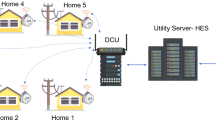Abstract
Advanced metering constitutes an essential component of communications between electricity suppliers and consumers. It may be possible to augment demand response by coupling Advanced Metering Infrastructure (AMI) with advanced implementations in homes. In this paper, we quantify the economic impact of such advanced implementations and show that these technologies promise to add value for both major stakeholders—electricity suppliers and the consumers. In particular, we present a comparative study by evaluating the adoption of Basic-AMI versus one that incorporates automation devices enabling communication and control. We present a linear programming modeling framework to capture demand response behavior while reflecting regulatory policies to ensure lower critical peak prices. Based on this framework, we present a case study for the state of Ohio, although the general nature of the analysis is applicable to other states as well. Our results show that dynamic pricing coupled with AMI—in particular, its advanced implementations—provides significant incentives to the utility, regulatory commission and the consumer.














Similar content being viewed by others
Notes
PROMOD is a widely used proprietary simulator available from Ventyx, Inc.
Generation costs account for about two-thirds of the cost of electricity.
PJM and MISO Fact Sheets from http://www.pjm.com and http://www.misoenergy.org.
Brattle Group, Memorandum to PUCO, 2010.
CPP is used as an acronym for critical peak price.
Load cost refers to the cost of supplying energy demand.
The peak or maximum LMP is maximum of the four hour block averages.
References
Price elasticity of demand for electricity: a primer and synthesis, EPRI (2007)
AmerenUE Residential TOU Pilot Study, RLW Analytics (2005)
Bazaraa, M.S., Sherali, H.D., Shetty, C.M.: Nonlinear Programming: Theory and Algorithms. Wiley, New York (2006)
Borenstein, S.: To what electricity price do consumers respond? Residential demand elasticity under increasing-block pricing (2009, unpublished)
Faruqui, A., Hanser, P.Q., Ryan, H., Palmer, J.: Assessing Ontario’s Regulated Price Plan: A White Paper. The Brattle Group Inc. (2010)
Faruqui, A., Sergici, S.: Household Response to Dynamic Pricing of Electricity A survey of the Experimental Evidence. The Brattle Group Report (2009)
Faruqui, A., Wood, L.: Quantifying the Benefits of Dynamic Pricing in the Mass Market. The Brattle Group Report for Edison Electric (2008)
Forecasting Price Responsive Demand in the MidWest ISO, The Brattle, Group (2009)
Gribik, P.R., Hogan, W.W., Pope S.L.: Market clearing prices and energy uplift (2007, unpublished)
Hobbs, B.F., Rothkopf, M.H., O’Neill, R.P., Chao, H.: Klewer International Series in Operations Research and Management Science, The Next Generation of Electric Power Unit Commitment Models (2001)
ONeill, R., Sotkiewicz, P., Hobbs, B., Rothkopf, M., Stewart, W.: Efficient market-clearing prices in markets with nonconvexities. Eur. J. Oper. Res. 164, 269–285 (2005)
Shapiro, J.: Mathematical Programming: Structures and Algorithms. Wiley, New York (1979)
Wang, C., Luh, P.B., Gribik, P., Li, Z., Tengshun, P.: A subgradient based cutting plane method to calculate convex hull market prices. Power and Energy Society General Meeting, IEEE (2009)
Acknowledgments
We thank the Public Utility Commission of Ohio (PUCO) for funding this research, and are grateful to the PUCO staff, particularly, Dan Johnson, Hisham Choueiki and David Wang for extensive discussions throughout the duration of the project. The software and data support provided by Ventyx is also deeply appreciated. We thank Binyuan Chen for his contribution. The authors acknowledge that the research reported in this paper was partially funded by NSF under Grant No. CMMI 0900070.
Author information
Authors and Affiliations
Corresponding author
Rights and permissions
About this article
Cite this article
Aketi, P., Sen, S. Modeling demand response and economic impact of advanced and smart metering. Energy Syst 5, 583–606 (2014). https://doi.org/10.1007/s12667-013-0113-1
Received:
Accepted:
Published:
Issue Date:
DOI: https://doi.org/10.1007/s12667-013-0113-1




